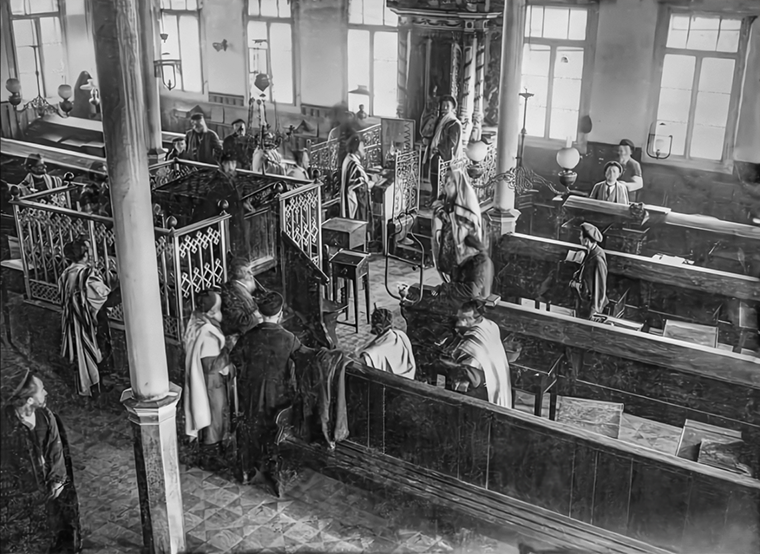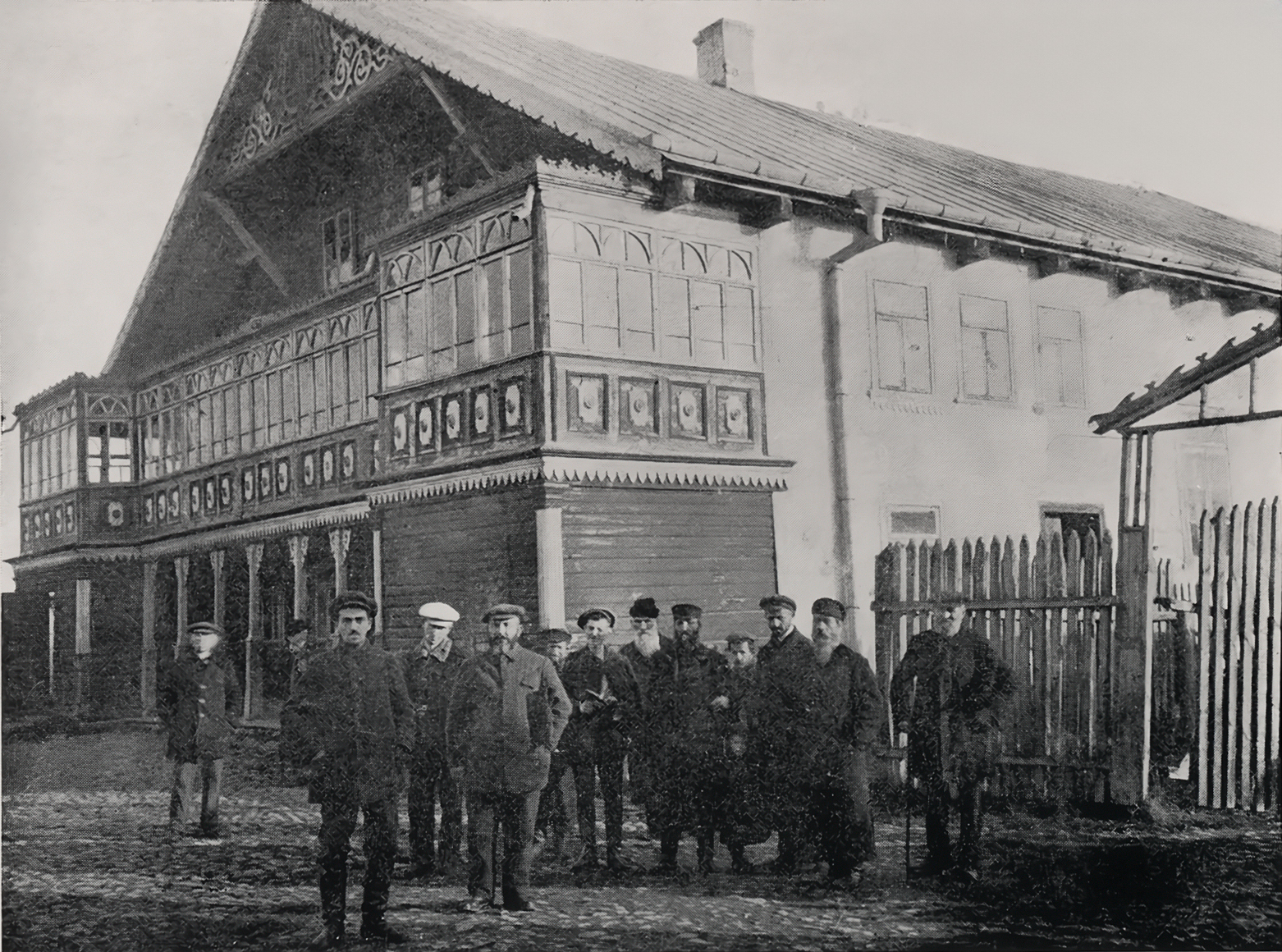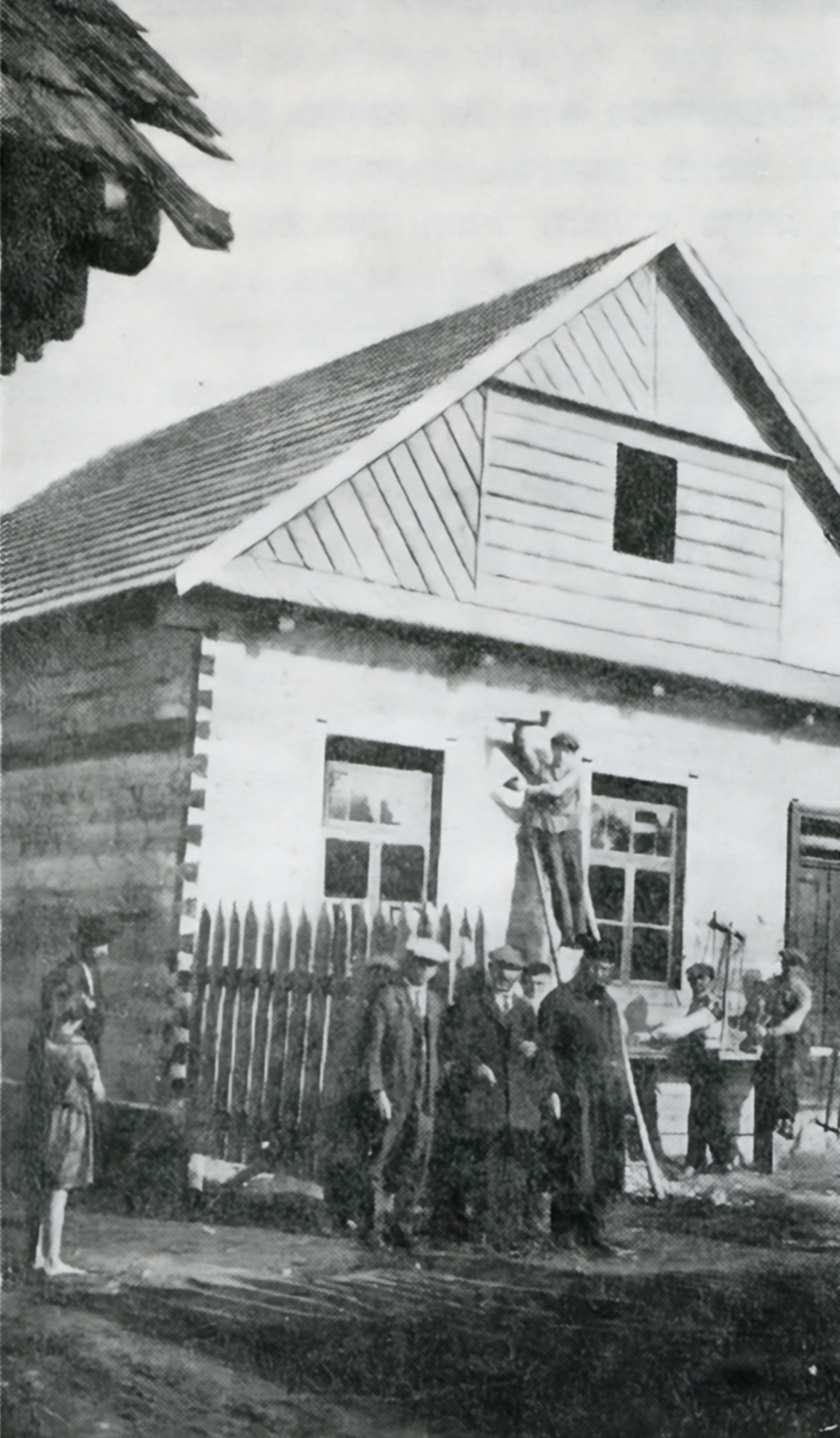
Bielsk Podlaski
The Yefeh 'Einayim Synagogue
“In 1898, construction of a new synagogue began, on the location of the earlier one from the 16th century. The new building was called the “Yefeh 'Einayim” [lit. lovely or beautiful eyes] synagogue, after the title of the book by the town's Rabbi, Aryeh Loeb Yellin. Beside it was the new beit-midrash (study house) “Sha'arei Tzion” (erected in 1889) and another beit-midrash.”1

Photograph of the
interior of the Yefeh 'Einayim wooden synagogue in Bielsk
Podlaski on page 169
of the Bielsk Podlaski Yizkor book. The caption reads:
"Photographed in 1919 by a Christian German soldier
who was impressed by the beauty of the building." The 1973
book "Rabbi Areyh Loeb Yellin, Author of "Yefeh 'Einayim""
by Rivka Ziskind,
dates this photo to 1921. Another source states that
holding the Torah scroll is Elie Korytski,
Chief Rabbi of Bielsk Podlaski. However, Rabbi Moshe Bendas
became Chief Rabbi in 1917. Photo contributed by Tomy
Wisniewski.
The Yefeh 'Einayim synagogue (as well as other synagogues and the town’s rabbis) was written about in the Bielsk Podlaski yizkor book, Bielsk-Podliask; Book in the Holy Memory of the Bielsk Podliask Jews Whose Lives Were Taken During the Holocaust Between 1939 and 1944. The chapter Centers of Interest in Bielsk on page 95:
“Another synagogue, which was called “Yefeh 'Einayim” (lit. beautiful eyes), was the shul for the elites, the grand figures of the city, and even its place and form indicated that. It stood on a high location in the center of a spacious garden with fruit trees and with benches for resting, and so forth. The windows of the building were wide, the ceiling of the hall was supported by pillars, but the holy ark was “modern” as in every other place.”

Photograph of the exterior of
the wooden Yefeh 'Einayim synagogue in Bielsk Podlaski,
taken during the interwar period.
The photo is on page 218 of the Bielsk Podlaski yizkor book,
in the chapter titled The Life Story of R' Aryeh Loeb
Yellin.
The
yizkor
book chapter "Bielsk Podlaski - My Birthplace," on page 262, states
that during WWI, "Two big fires severely damaged the city, one
during the battles when the three synagogues that were
concentrated on one square were burned. “The Alter,” “The
Alt-Niya” and the “Hachnasaat Orchim Synagogue” as well as the
shtibel [small prayer house or room] of the chassidim,
the municipal bath and the “Hekdesh” – the shelter for
paupers. After that, a large fire destroyed almost an entire
street in the center of the city." The maps linked to below
show the proximity of the synagogues.

From "Yefeh 'Einayim [יפה
העינים] (Rabbi Aryeh Loeb Yellin)" on page 167, part
of the chapter "The Rabbis' Deeds," in the Bielsk
Podlaski Yizkor book.
The caption reads: "After the fire, the Beit Midrash
is rebuilt."
The
synagogue was within the boundaries of the ghetto created by
the Nazis in 1941. It served as the headquarters of the
Judenrat (Jewish Council established by the Nazis) and the
meeting place of the Jewish police. From time to time the
Germans stormed the building.2 The approximate
boundaries of the ghetto, and the Jewish sites within it, can
be seen on this Google
map. A memorial plaque placed on the site of the former
Shaarei Zion synagogue, displays a map
of the center of town. It includes partial boundaries of the
ghetto and the former location of the Yefeh 'Einayim synagogue
as well as other Jewish sites.
In the chapter "In
the Holocaust in Russia and also Bielsk Before and After its
Destruction," on page 144, the
author wrote that after WWII "I heard that the central Great
Synagogue was dismantled and its parts were sold." In this story about
the discovery of a Torah scroll in Bielsk by the family of
Moshe Alpert, who wrote three chapter in the yizkor book on
pages 165, 235, and 462, it is said that Jews were herded
into the synagogue which was then set on fire. Another story
is that the synagogue was dismantled because the wood was
needed to construct the wall that the Jews were ordered by the
Nazis to build around the ghetto.
1. Bielsk chapter of Pinkas Hakehillot Polin, Encyclopedia of Jewish Communities in Poland, Volume VIII. <return>
2. “In
the Bielsk Ghetto & the Camps,” by Meir Peker, in Bielsk-Podliask;
Book in the Holy Memory of the Bielsk Podliask Jews Whose
Lives Were Taken During the Holocaust Between 1939 and 1944.
<return>
Updated
March
14, 2024
Copyright © 2023 Andrew Blumberg
JewishGen Home Page | KehilaLinks Directory
This site is hosted at no cost by JewishGen, Inc., the Home of Jewish Genealogy. If you have been aided in your research by this site and wish to further our mission of preserving our history for future generations, your JewishGen-erosity is greatly appreciated.